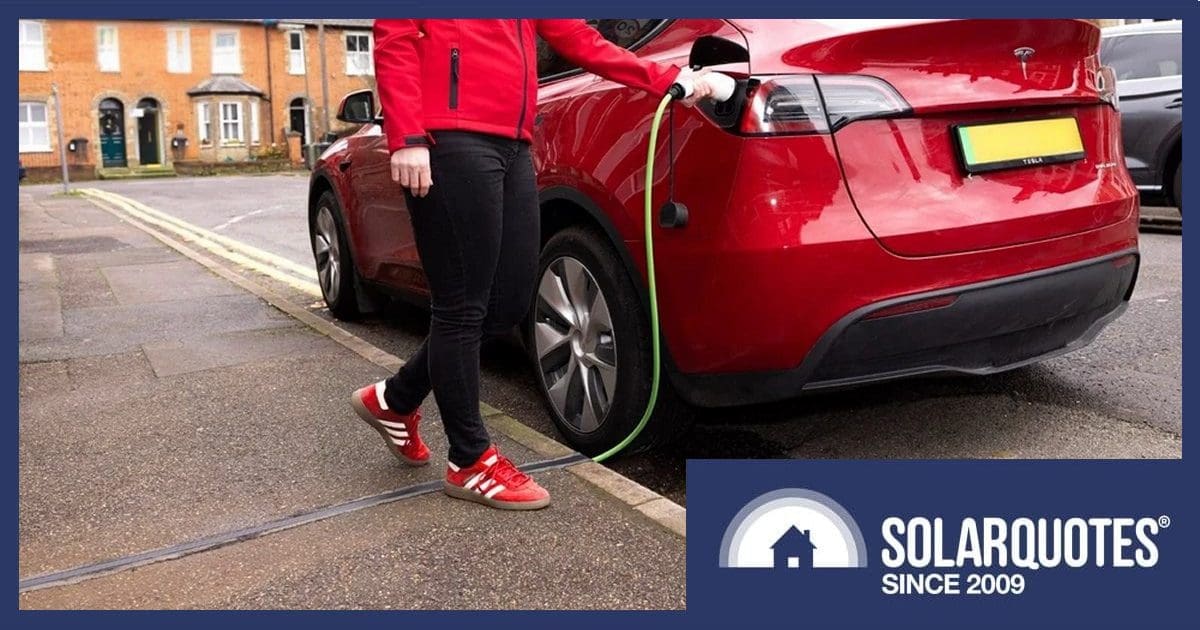
Dozens of councils in the UK are permitting and promoting cross-pavement EV charging systems for electric vehicle owners without a driveway. Is it time Australian councils followed suit?
Home EV charging is usually a breeze for those with a driveway. But for Australians who don’t, it can negatively impact on the electric vehicle ownership experience. Using public charging stations is of course an option, but may not be as convenient and can cost significantly more.
It’s little wonder then some affected EV owners are using weird and wonderful (and unsafe) ways to charge their vehicles on the street.
One of the better/safer ways to go about it in certain scenarios is with an EV cable channel or gully across the footpath done right. And done right includes having your local council give its blessing. But as far as I know none in Australia are currently.
Over in the UK, it’s a different story.
An example is Richmond upon Thames London Borough Council, or just Richmond Council to its friends. Following a successful trial, a new initiative launched late last month for eligible residents to have “footway channels” that allow safe cable routing from properties to kerbside parked EVs.
“One of the biggest barriers to EV adoption is the challenge of charging at home for those without off-street parking,” said Councillor Alexander Ehmann. “This scheme widens the opportunity for residents to make the switch to an electric car – with access to a price-competitive home electricity supply.”
… particularly if those households have installed solar panels.
But it’s not just a matter of grabbing a concrete saw and making your own.
The Process And Cost
The process involved is first reading through a bunch of conditions to determine eligibility and responsibilities, and then applying online. There are two stages to Richmond Council’s application process, each with its own non-refundable fees.
The first fee is paid with the initial online application: £100 — around A$205 at current exchange rates. If the application is successful, a one-off payment of £1,250 (around A$2,560!) will need to be made to cover the cost of purchasing and installing the channel.
But the costs don’t end there. Use of the cable channel will be subject to a three-year renewable licence costing £150 (~A$307) a pop.
Added to all that, installation of the channel doesn’t mean other vehicles can’t park in that spot.
While this will only appeal to keen *and* cashed-up EV owners, it’s a start — and Richmond Council has indicated the installation fee may drop if it receives a grant from a new £25m (~A$51.2m) UK government fund set up to help cover the cost of installing channels.
The Cable Channel Product
The product being supplied and installed for Richmond Council is Kerbo Charge, but it’s not the only product of its nature around. The company, founded in 2021, says the Kerbo Charge solution is “live” with 30 local authorities across the UK.
The Kerbo Charge duct can take any cable up to 20mm diameter, which includes Type 2 charging cables. It works a bit like a zipper — the lid is lifted at one end and the charging cable is inserted in sections. The lid closes up behind automatically, as it does when the cable is pulled out.
It’s strong, slip-tested has a life expectancy of over 25 years, with a hinge mechanism rated to open and close at least 25 million times.
Kerbo Charge Eyeing Australia
I clicked through to Kerbo Charge’s “get started” page out of curiosity and was directed to their page for Australians. The company appears keen on setting up here, inviting Australians to register to show support for a trial in their local area, and the possibility of benefiting from such a trial.
If you’re interested in getting an EV charging cable channel out the front of your place, make some (polite) noise with your local council. Given federal and various state governments are throwing some EV cash around for kerbside solutions, perhaps they’ll also prod the powers-that-be to offer a grant program to help subsidise the cost.
Another kerbside charging approach — an “over the pavement” solution — we’ve touched on before is ChargeArm.

 RSS - Posts
RSS - Posts



I have to admit, as an Australian visiting London earlier this year, I was conflicted by this. It obviously allows greater flexibility for EV charging, but the liability issue left me wondering who’s responsible if someone has an accident.
Some councils are allowing cables across kerbs. I live in the Inner West of Sydney and the Inner West Council will provide a one year license permitting across curb cable provided that the license is displayed while charging and that an adequate cover is applied over the cable. This is a sensible solution and eliminates the need for cable channels to be cut across multiple footpath locations.
personally I like it I feel they should have waved the licencing fee, as long as the channel is level with the foot path its a great idea. (it still will have limited use but it gives more people options )
I feel they are missing an opportunity here. We should instead allow DNSPs to install pole mounted EV chargers that are slow charge only (and ideally bi directional) if they charged at say 3.6Kw/h and you could park your car there all day (whilst at work on public transport etc) and they limited the cost per Kwh to a sliding scale depending on time of day – say during the solar duck curve – Wholesale FIT x 1.25 as an example, then they would provide an alternate revenue stream for DNSPs to help offset the otherwise inevitable increase in household daily connection charges.
They also provide an outlet for excess power on a local level during the daily duck curve and longer term if they were bidirectional would enable an opt-in service to enable grid support as and when needed.